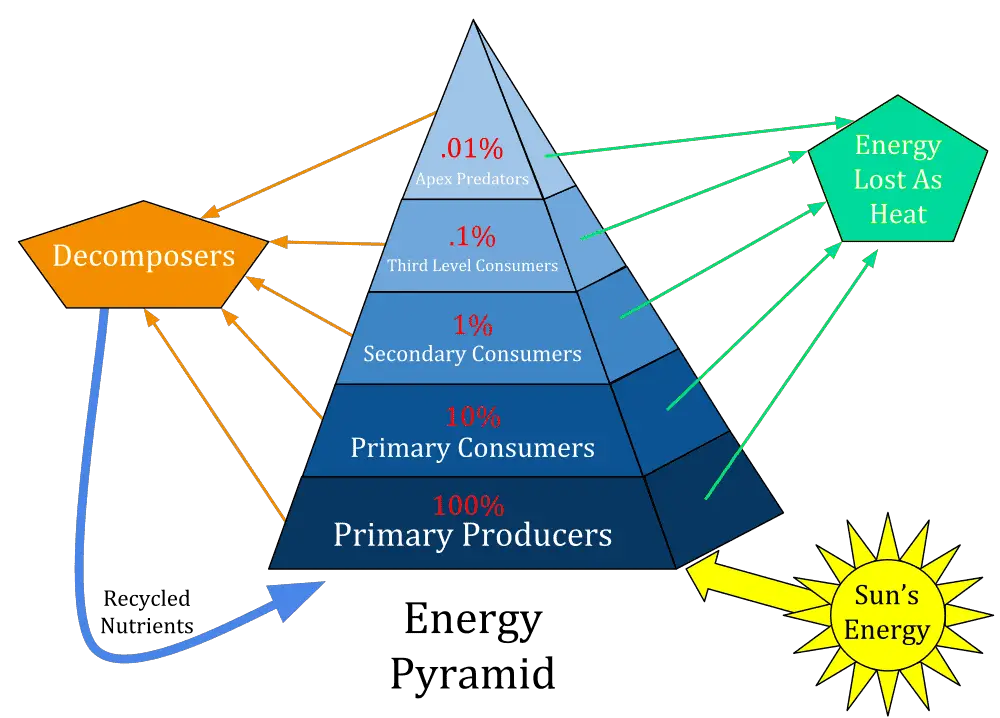Natural communities of different species play an essential role in sustaining each other and their human consumers. Decades of disaster have taught us the importance of conserving the natural life on which we depend. This conservation requires the measurement of dynamic systems involving diverse life forms.
A pyramid of biomass is a diagram of the biomass in an ecosystem at a point in time. It classes the living organisms in tiers called trophies, whose members do not ordinarily feed off each other. The pyramid structure shows declining mass in higher-consumption trophies.
Understanding the picture includes delving into:
- The composition of a trophe.
- Variations on the ecological pyramid.
- Pyramids of number.
- Pyramids of energy.
- The use of pyramids of biomass.
- How pyramids are transformed.
We’ll start with the founding concepts and work our way up the fascinating structure.

What Is The Pyramid Of Biomass?
A pyramid of biomass is a graph depicting the quantities of and relationships between biomass in a specified area at a given time.
These diagrams are part of a system of visualizing ecosystems specified by biologist Charles Elton in the 1920s. Elton was primarily concerned with showing energy dissipation and transfer in an ecosystem.
A pyramid of biomass consists of several trophic levels stacked on top of the other. Relationships of dependence are represented vertically. Organisms in the same trophic level are independent of each other for direct energy transfer.
All organisms are dependent on some organism(s) in the level immediately below. This dependence is usually satisfied by consumption (the organisms in the higher level eat the lower-level life on which they depend.) The organisms in the lowest level obtain their energy from the sun.
What Is Biomass?
The term ‘biomass” combines “biological mass.” It represents the weight of “over-dried” organic matter that an ecosystem holds at a given time. It is often referred to as “production’, and refers to dead organic matter as well as the living.
Over-drying features are significantly defined as biological materials containing water to varying degrees. While water adds to the mass of organisms, it is not involved in transferring energy between them or the ecology’s general store of energy. By way of example, coal is more efficient than wood-burning diverts energy in drying.
Notably, the definition of biomass is relative to a given location at a point in time. The term, on occasion, is used loosely (and incorrectly) to refer to organic matter generally.
In measuring, biomass is differentiated by type. This differentiation helps because organisms differ in their suitability to different measurement forms. Differences in moisture, visibility, and seasonality also affect living matter. Once categorized, correlation tables between types facilitate the estimation of the mass.
What Are Trophic Levels?
The Greek word “trophe” denotes food, and a trophic level is a category of organisms in the same or similar feeding mode. Trophic levels grouped by mode, not type of organism.
There are two main major organism types, differentiated by feeding mode. Autotrophs are organisms capable of producing organic matter from inorganic sources. Heterotrophs lack this capacity and feed on other organisms (themselves either autotrophs or heterotrophs) to obtain organic matter.
Types of autotrophs include algae and bacteria. Heterotrophs, who hunt and gather their food, are consumers. Types of heterotrophs are bears and venus flytraps. The partitioning of biomass into trophes is referred to as trophic structure. This partitioning is the basis of the pyramid of biomass.
What Is A Food Chain?
A food chain is a sequential ordering of trophic levels. The first (lowest) level consists of autotrophs. At any level, the containing organisms are either Level1 autotrophs, or they are heterotrophs feeding upon organisms available in the immediately preceding trophic level.
In an ecological system, the following five types of trophic level are recognized:
- Primary Producers: This level includes autotrophs that produce the energy that sustains the whole pyramid. They are plants that derive their energy from the sun and nutrients in the soil.
- Primary Consumers: These organisms derive their energy by consuming primary producers. Examples are insects and herbivores like cattle.
- Secondary Consumers: Secondary consumers obtain their energy by consuming primary consumers. Examples are snakes and tigers.
- Tertiary Consumers: Some chains include consumers of the secondary consumers. This categorization may include humans who consume carnivores.
- Decomposers: These are organisms that break dead organic matter into forms that other organisms consume. The decomposer trophic level is usually a parallel level to the chain.
The order of presentation above is the bottom-to-top order in which they’re usually presented, with producers living at the chain’s base. Two things set one food chain apart from another:
- Its trophic structure.
- The specific organisms inhabiting a trophe.
What Are The Types Of Ecological Pyramid?
Food chains create the basis for ecological pyramids. The three types are the pyramid of number, the energy pyramid, and the biomass pyramid mass.
What Is A Pyramid Of Number?
A pyramid of numbers is a picture representation of the population in an ecosystem, broken down into interdependent tropes. Each level shows the total number of organisms estimated to exist in that trophe in the ecosystem at the time of reference.
Elton introduced this pyramid in 1927. He observed that, of necessity, organisms in the higher trophies need to outnumber their food sources in the lower trophes (e.g., an eagle will not eat only a single snake throughout its lifetime, or even a week.)
This consumption leads to an upright pyramid in which the organism count diminishes rapidly as we approach the top. Millions of producers can sustain a pyramid with only a few score carnivores at the top in a typical ecosystem.
What Is A Pyramid Of Energy?
A pyramid of energy shows, in diagrammatic form, the concentration of energy at different trophic levels of an ecosystem.
Sometimes this structure is referred to as a trophic pyramid or ecological pyramid. The structure of the pyramid implies two things – the flow and efficiency of energy transfer in the ecosystem:
- Flow: Energy moves from organisms at lower levels to organisms at higher levels. The energy reading for a higher trophe represents energy available at the immediately lower trophe before consumption.
- Efficiency: Energy levels drop off as you climb higher up the trophic ladder. This drop is because energy is lost through waste as well as the energy-intensiveness of the consumption process itself. The percentage of the lower level energy that makes it to the higher level is the energy efficiency at that tier of the pyramid.
What Is A Pyramid Of Biomass?
This diagram shows the biomass available at various trophic tiers in an ecosystem.
Refer to the definition of biomass canvassed above. As with energy and number pyramids, these diagrams show the total amount of the metric of reference (in this case, dry mass) available at a trophe.
One problem with biomass is that it does not translate immediately into energy for the next-level trophe. This is because some elements of the animals’ biology (e.g., skeletons and feathers) are inedible by their predators.
Pyramids are a helpful way of assessing biomass total biomass. Where species constitution of the trophes and inter-trophic proportional relations are known, the mass of an entire ecosystem can be estimated by measuring its top tier only.
As discussed, the top-tier will consist of a few discrete (and therefore easily countable) specimens.
Calculating total system biomass then takes the form of estimating the top tier mass and multiplying by the known proportions all the way down the trophic structure.
What Is A Transformed Pyramid?
Transformed pyramids have higher metrics (for number, energy, or biomass) at higher trophes in the structure. These structures are known as inverted pyramids.
An example of an inverted pyramid is the pond ecosystem. Here the primary producers are phytoplankton. They always are smaller in number and biomass than the higher-trophe organisms, and they compensate by having a higher reproduction rate than the other life forms in the ecosystem.
As a result, a single generation of zooplanktons – the next-trophe consumers – live off multiple generations of phytoplanktons.
Decades of research in temperate and tropical reefs have generated much knowledge of how species shape interplays with community ecology. This has led to an ability to predict the sizes of species communities, subject to certain constraints.
Research has shown that inverted biomass pyramids are widely reported in aquatic ecosystems. This is expected to be the default arrangement in ecosystems with no human exploitation.
Why Is The Pyramid Of Biomass Important?
The principle utility of the pyramid is for the calculation of energy available in an ecosystem.
Biomass is a source of renewable energy, and being able to calculate biomass is important in the sustainability assessment of renewable energy plants. Key metrics of interest are total mass, efficiency, and concentration.
Total mass gives an indication of whether the plant will have sufficient biofuel to meet its energy requirement. This is the primary reason for calculating biomass.
Efficiency measures the loss of energy within the ecosystem. An energy inefficient may be desirable from an energy production point of view, as it implies that tertiary consumers leave harvestable waste.
The distribution of biomass shows where the energy-rich trophies are. Ideally, energy plants want to harvest low-tier producers, like algae. These are easier to decompose and produce few ethical concerns.
Studying different instruments gives insight into managing the ecosystem for energy efficiency. By introducing or removing targeted species, the energy flow and biomass yield of an ecosystem can be enhanced as its pyramid structure is altered to replicate known high-yield structures observed in similar climes.
In conserving ecosystems, a tiered analysis can expose trophies that need to be buttressed in order to sustain the ecosystem at large. Culling may be warranted in the case of rapacious predation.
Pyramid Of Biomass FAQ
We consider some questions that arise in the pyramid theory of biology.
Who Was Charles Elton?
Charles Sutherland Elton was an animal ecologist and zoologist born in England in 1900. He graduated and spent his entire academic career at Oxford University. His early work was heavily influenced by studies on the cascading effect that human overpopulation had on natural ecologies.
What Is A Food Web?
Animals do not always eat off one trough only. A food web is a structure in which individual food chains are interlinked to show how certain species in a trophy may depend on more than one level in other food chains. It gives a less linear, more accurate depiction of interdependency and creates a basis for webs of biomass.
What Is The 10% Rule?
Not all the energy in a trophic level passes to the consumers at the next tier. Much of it is dissipated in the form of heat during the consumption process. Some of it becomes organic waste. On average, 10% of the consumed energy arrives at the consuming trophe.
What Is An Inverted Pyramid Of Energy?
Inversion of an energy pyramid is an impossibility. This is due to two reasons:
- Energy cannot be destroyed or created, only transferred.
- There are no primary productive carnivores.
The pyramid of energy is structured so that the only consumers of energy from outside the system (the producers and decomposers) are situated at the base or outside of the pyramid.
An inversion of the pyramid would imply that there is a trophe where consumers are able to either create new energy or import it from outside the system. But the two reasons cited above show that this is not possible.
What Is Trophic Cascade?
This is the result of a change of number at the top of a pyramid. When large numbers of predators are increased at the top of a three-trophe pyramid, this causes a reduction in the number of herbivores (due to overfeeding) and a surge in the number of producers (given a drop in the number of their consumers.)
The effects of the cascade are the opposite in the case of a decrease in predators. Corresponding changes to the biomass are triggered, although whether these are sustainable depends on the extent of the top-trophe changes.
What Is The Role Of Solar?
The primary producers at the pyramid’s base need energy from outside the system in order to produce biomass. They produce by a process called photosynthesis, where the energy is provided by the sun.
An exception is the ecosystems that form on the ocean floor around the edges of tectonic plates. The producers here have no access to the sun, accessing geothermal energy instead. They use heat from magma in a process called chemosynthesis.
Where Do Humans Fit In The Pyramids?
Humans generally are tertiary consumers in food chains. Although were are susceptible to predation, humans have effectively insulated themselves from their predators and sit atop the food chains in which they feature. We have the greatest cascading effect on all species.
References




